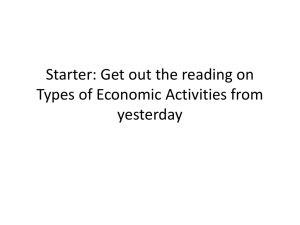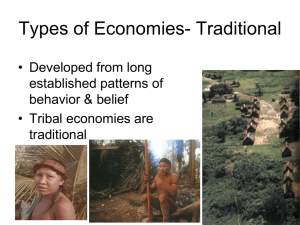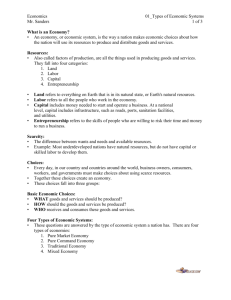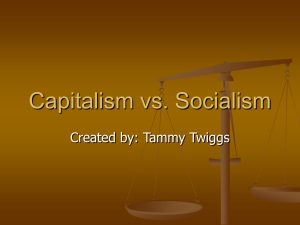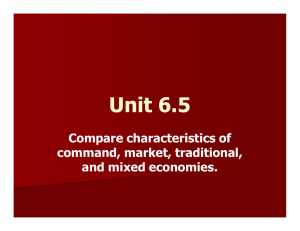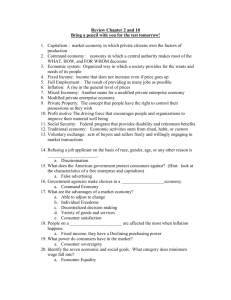Alternative Economic Systems
advertisement
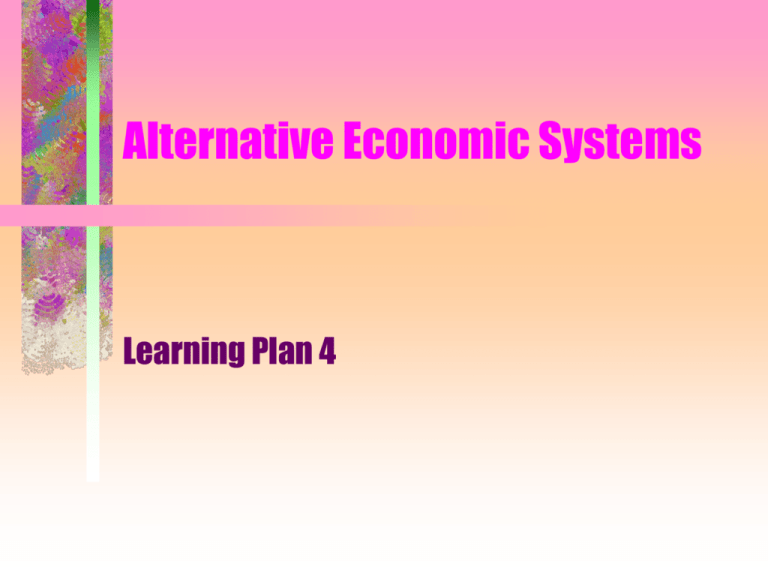
Alternative Economic Systems Learning Plan 4 Alternative Economic Systems • Questions • 1. Why does the scarcity problem force all societies to answer the questions what, how, and for whom? • 2. How can economies be classified? • 3. What are the characteristics of an command socialist economy? • 4. What are some problems that command socialist economies face? Economic Systems • Economic System is the institutional means through which resources are used to satisfy human wants. Economic Systems • • • • • • Unlimited wants/ scarce resources Rules Channeling competition Resolving conflict Laws Customs Economic Systems • 1. Capitalism. An economic system in which individuals own productive resources; these individuals can use the resources in whatever manner they choose, subject to common legal restrictions. • A. Property rights. The right of an owner to use and to exchange property. Economic Systems • Socialism. An economic system in which the state owns the major share of productive resources except labor. Socialism also usually involves the redistribution of income. Economic Systems • Communism. An economic system in which the state has disappeared and in which individuals contribute to the economy according to their productivity and are given incomes according to their needs. • In pure communism, we would see the absence of economic class distinctions. • Centrally planned (command) economies. Economic Systems • Two classifications • 1. Market System. A system in which individuals own the factors of production and decide individually how to use them; a system with decentralized economic decision making Economic Systems • 2. Command System. A system in which the government controls the factors of production and makes all decisions about their use and about the distribution of income. Economic Systems • No matter what the system, the fundamental economic problem of scarcity must be solved. • Every economy faces opportunity costs in making decisions. 3 Basic Economic Questions • Resource Allocation • The assignment of resource to specific uses determining what will be produced, how it will be produced, and for whom it will be produced. What, How, And For Whom To Produce Is The Function of Price • What • What is produced is determined by the dollar votes that we cast for things and by the dollar costs of producing those things What, How, And For Whom To Produce Is The Function of Price • Whom • For whom to produce is determined by the price the market creates for resources that people own-things like land, capital, and our labor services. What, How, And For Whom To Produce Is The Function of Price • How • How goods are produced is determined as business firms compare the relative prices of resources-land, labor, capital, and entrepreneurship • Firms want to develop lowest-cost combination of resources Least-cost Combination • The level of input use that produces a given level of output at minimum cost. Market Prices • Market prices communicate crucially important information: • 1. To consumers about product availability. • 2. To producers about consumer preferences • 3. To individuals above the relative value of particular kinds of knowledge and skills Market Prices • Prices ration resources and goods • 1. When something is scarce, the quantity of is insufficient to allow everyone to have as much as they like. • 2. There must be some method of determining who gets how much of scarce things Market Prices • Price acts as a message to the market participants. • The price system is the messenger. • 1. The price system delivers a message about changing market conditions. • 2. The price system delivers does not create the changing market conditions. Extreme Economic Systems: Market Capitalism and Command Socialism Market Capitalism In Theory 1. Private property rights exists, are legal, and are upheld by the judicial system Market Capitalism In Theory • 2. Prices are allowed to seek their own level as determined by the forces of supply and demand. In this sense, pure capitalism is a price system. Market Capitalism In Theory • 3. Resources, including human labor, are free to move in an out of industries and geographic locations. The movement of resources follows the lure of profits-higher expected profits create an incentive for more resource to go where those profits might occur. Market Capitalism In Theory • 4. Risk takers are rewarded by higher profits, but those whose risks turn out to be bad business decisions suffer the consequences directly in terms of reduced wealth. Market Capitalism In Theory • 5. Decisions about what and how much should be produced, how it should be produced and for whom it should be produced are left to the market. In a pure market capitalist system, all decisions are decentralized and made by individuals in a process of spontaneous coordination throughout the economy. Laissez Faire • An economic system in which the government minimizes its activity within the economy. Three of Attributes of Market Capitalism • Prices • Profits • Private Property Government Role in Capitalist System • Limited to certain goods • Legal framework Command Socialism in Theory • Command Socialism. An economic system in which there is virtually no private property and the state owns virtually all the factors of production. Decisions about what and how much, by whom and for whom are decided by command from a central authority. Command Socialism in Theory • 1. Most of the major factors of productions are owned by the state. Private property rights are strictly limited to small tools that an individual needs for an occupation. Land, factories, and major machinery are never privately owned. • 2. Most prices are set by the state rather than by the forces of supply and demand. Command Socialism in Theory • 3. The movement of resources, including labor, is strictly controlled. Resources typically move only when dictated by a centralized planning authority. • 4. Economic decisions about what and how much, how, and for whom are all made by the state through its central planning agencies and other administrative units. Command Socialism in Theory • 5. Little individual risk taking is allowed; rather, risk taking in the form of new ventures is undertaken by the state. All citizens benefit from successful risk taking, and all citizens pay for unsuccessful risk taking, but not directly through immediate reduction in individual income and wealth. Command Socialism in Theory • 6. Taxation is often used to redistribute income. Economic Planning • Does economic planning occur in a centralized command economy and not in a decentralized market economy? Incentive Structure • The motivational rewards and costs that individuals face in any given situation. • Each economic system has its own incentive structure. Mixed Economies • An economic system in which decisions about how resources should be used are make partly by the private sector and partly by the government, or the public sector. • What is the future of mixed economies? China: Past, Present, and Future Movement Toward The Market In Russia Changes In Other Parts Of The World


